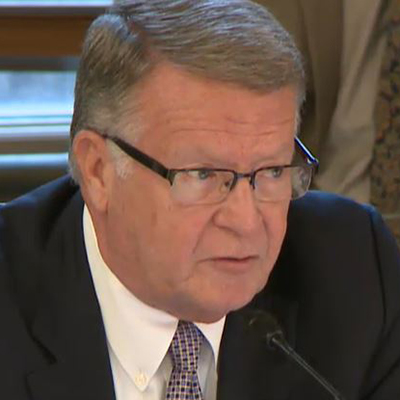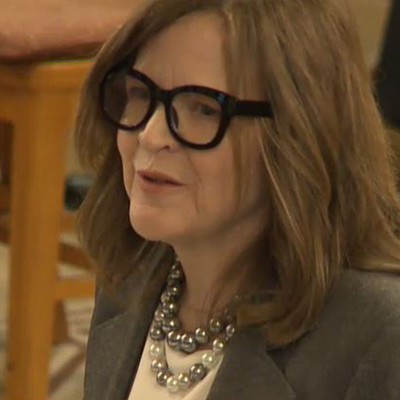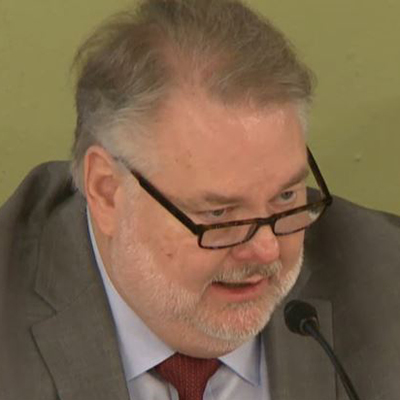
 Glen Thomas, P3 | The Ohio Channel
Glen Thomas, P3 | The Ohio Channel
PJM stakeholders in the RTO’s generator sector Tuesday voiced frustration with FERC over recent decisions related to the capacity market, especially multiple delays to the Base Residual Auction (BRA), to a receptive audience in the Ohio Senate Energy and Public Utilities Committee.
The testimony from Glen Thomas, president of the PJM Power Providers Group (P3), prompted one senator to question whether the legislature could explore leaving the RTO.
Thomas told the committee that capacity resources in Ohio have done “very, very well” in the capacity market. Ohio has seen more than a dozen new power plants constructed in the last 15 years, leading to billions of dollars in investments and thousands of jobs, he said.
PJM’s capacity reserve margin numbers are currently “very strong,” Thomas said, creating short-term confidence in the market. But in the long term, P3 is “growing increasingly concerned” that reliability is going to become more of an issue in the future in PJM.
 Sen. Steve Wilson | The Ohio Channel
Sen. Steve Wilson | The Ohio Channel
“There’s a lot of things that have been occurring at the federal level that have a direct impact on Ohio’s energy policy, and there’s quite frankly some reasons to be concerned,” Thomas said.
Sen. Steve Wilson (R) said he was “scared to death” thinking about the long-term reliability issues Thomas talked about.
Wilson asked Lori Sternisha, director of the Office of the Federal Energy Advocate for the Public Utilities Commission of Ohio, what the legislature could do if FERC ends up forcing Ohio to pay for projects like offshore wind in New Jersey.
“Would we look to drop out of PJM, or what is our fallback plan if all of a sudden our reliability gets unacceptable and our price gets unacceptable?” Wilson asked.
 Lori Sternisha, PUCO | The Ohio Channel
Lori Sternisha, PUCO | The Ohio Channel
Sternisha said her office is concerned with long-term reliability issues based on recent FERC decisions, but that PJM is responsible for making sure there are reliable resources throughout the RTO, and it continually conducts reliability studies. She said if new generation isn’t located close to load centers, new transmission may be a solution.
“It would be my hope going forward that we not run away from PJM but use our oversized voice to direct the policy and do the best we can in that regard,” Sen. Mark Romanchuk (R) said.
Regulatory Uncertainty
Panelists at the hearing spoke about the impact of PJM’s minimum offer price rule (MOPR) on Ohio’s energy sector.
PJM’s narrowed MOPR took effect in September after FERC deadlocked 2-2 on the RTO’s proposal to apply it only to resources connected to the exercise of buyer-side market power or those receiving state subsidies conditioned on clearing the capacity auction. The proposal became effective by operation of law under Section 205 of the Federal Power Act when the commission failed to act within 60 days. (See FERC Deadlock Allows Revised PJM MOPR.)
Thomas said PJM had used the MOPR to “keep competition fair and the playing field level” among states and to take subsidies out of the marketplace. But he said many states in the RTO are using subsidies to incent renewable generation, and without the MOPR, subsidized resources “enjoy a leg up” in the marketplace and Ohio resources are on an “uneven playing field.”
“We believe the market should dictate winners and losers,” Thomas said. “We believe that competition that drives down costs is a good thing.”
Thomas said P3 has also grown concerned about the pace of plant closures resulting from delays in the running of PJM’s capacity auctions. He said delays in the Base Residual Auction have led to closures for plants that may have been viable in an auction run on time.
The BRA for delivery year 2023/24 has been delayed three times — from May 2020 to December 2021, then to late January, and finally to mid-June — each from separate FERC orders on different aspects of the capacity market. (See FERC Approves PJM Capacity Auction Date Changes.)
 Arnie Quinn, Vistra | The Ohio Channel
Arnie Quinn, Vistra | The Ohio Channel
Arnie Quinn, chief economist for Vistra (NYSE:VST), cited the retirement of Vistra’s 1,320-MW coal-fired William H. Zimmer Power Plant, announced last summer.
The plant was originally scheduled to retire by 2027, but the deactivation was moved up to May 31. Quinn said the change was made after the results of the 2022/23 BRA last May — also delayed multiple times from its original May 2019 date — when auction prices cleared lower than Vistra expected, making the plant unprofitable. (See Capacity Prices Drop Sharply in PJM Auction.)
Quinn said Vistra debated keeping Zimmer in operation to see if capacity prices “rebounded” in the 2023/24 BRA. But he said FERC’s decision on PJM’s market seller offer cap (MSOC) and more delays in the auction made it “clear” that the commission was going to make it more difficult “to use our commercial and engineering judgment to reflect our costs” when the offers were presented to the capacity market.
“We should have had the opportunity to go to the market with a bid that reflected our view on how much it would take to keep that plant open,” Quinn said. “We didn’t give the market that option because we sensed a risk that those rules were going to disadvantage us.”
Sternisha said her office has voiced concerns before FERC on fair and competitive wholesale markets, ensuring Ohio ratepayers are not burdened by public policy initiatives of other states and advocating for control of increasing transmission costs.
FERC’s inaction on the MOPR and the repeated auction delays over the objections of PUCO are “concerning,” she said, and a wholesale capacity market without “appropriate guardrails” doesn’t provide reasonable price signals or compensation to all generating resources. The MOPR has been changed so many times that it was “watered down to the point that it provides little screen for subsidized, uneconomic resources entering the PJM capacity market.”
Senators’ Questions
 Sen. Mark Romanchuk | The Ohio Channel
Sen. Mark Romanchuk | The Ohio Channel
Sen. Romanchuk asked about Ohio and Pennsylvania’s combined energy consumption in PJM.
Sternisha said Pennsylvania represents 19.7% of load in PJM, while Ohio is at 19.3%.
Romanchuk said that should give the two states an “oversized voice” in PJM and federal policy decisions. Sternisha responded by saying she believes they “carry a lot of weight” in PJM and at FERC.
Sen. Teresa Fedor (D) asked if PJM’s capacity market has protections against generation resources that are “trying to game the system” through offering artificially low prices in auctions.
Quinn said the MOPR “is and was” the mechanism PJM has to deal with prices, and the new rule means “essentially no resource now has any limitations on how low they can get.”
Fedor asked Quinn what types of resources in PJM are “trying to game the system.”
Quinn said he wouldn’t characterize resources’ bidding behavior that way. “They have another revenue source that offsets the other costs that the wholesale market needs to pay for,” he said, referring to state subsidies. “That resource is reflecting that in their offer. I wouldn’t say the resource is gaming anything. The resource is expressing what their economic interests are. The state has changed the playing field for all resources.”
